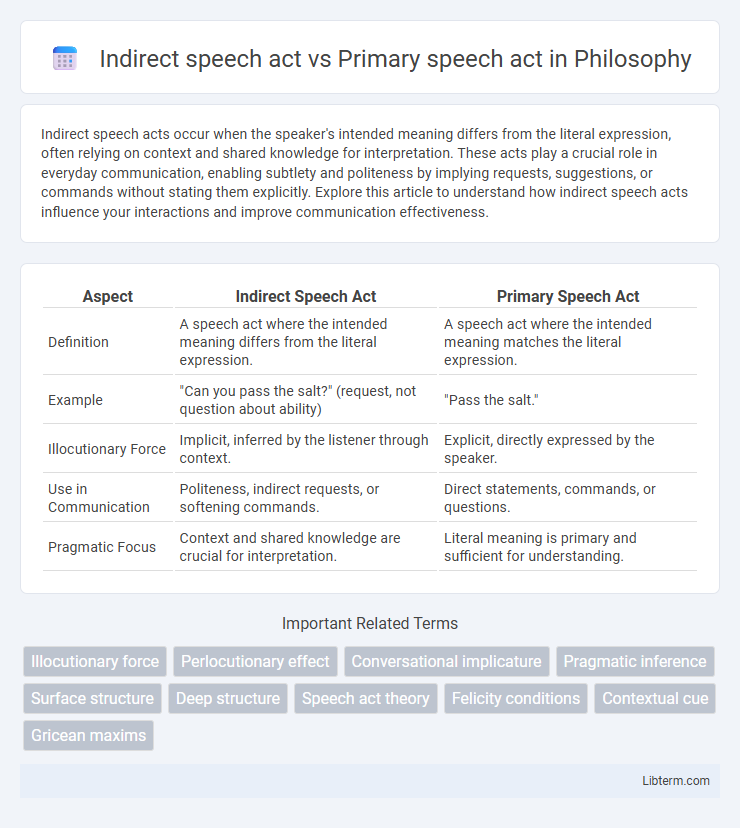Indirect speech acts occur when the speaker's intended meaning differs from the literal expression, often relying on context and shared knowledge for interpretation. These acts play a crucial role in everyday communication, enabling subtlety and politeness by implying requests, suggestions, or commands without stating them explicitly. Explore this article to understand how indirect speech acts influence your interactions and improve communication effectiveness.
Table of Comparison
| Aspect | Indirect Speech Act | Primary Speech Act |
|---|---|---|
| Definition | A speech act where the intended meaning differs from the literal expression. | A speech act where the intended meaning matches the literal expression. |
| Example | "Can you pass the salt?" (request, not question about ability) | "Pass the salt." |
| Illocutionary Force | Implicit, inferred by the listener through context. | Explicit, directly expressed by the speaker. |
| Use in Communication | Politeness, indirect requests, or softening commands. | Direct statements, commands, or questions. |
| Pragmatic Focus | Context and shared knowledge are crucial for interpretation. | Literal meaning is primary and sufficient for understanding. |
Introduction to Speech Acts
Speech acts are fundamental units of communication where the speaker performs an action through utterance. Primary speech acts convey the literal meaning directly intended by the speaker, such as asserting, questioning, or commanding. Indirect speech acts occur when the speaker implies a different intention than the literal expression, relying on context and shared understanding for interpretation.
Defining Primary Speech Acts
Primary speech acts include assertives, directives, commissives, expressives, and declaratives, each serving a specific communicative function such as stating, requesting, promising, expressing feelings, or declaring change. These acts are direct expressions where the speaker's intention matches the literal meaning of the utterance. Understanding primary speech acts is fundamental in pragmatics for analyzing how meaning and intention align in communication.
Understanding Indirect Speech Acts
Indirect speech acts occur when the intended meaning differs from the literal expression, requiring the listener to infer the speaker's intention beyond the primary speech act. Primary speech acts directly express the speaker's intention through explicit statements, such as requests, commands, or assertions. Understanding indirect speech acts is crucial for effective communication as it involves recognizing context, social cues, and shared knowledge to accurately interpret implied meanings.
Key Differences Between Indirect and Primary Speech Acts
Indirect speech acts convey the speaker's intended meaning through implied or non-literal expressions, whereas primary speech acts involve direct, explicit communication of intent such as asserting, questioning, or commanding. Key differences include the presence of an underlying, indirect message in indirect speech acts, requiring context and inference, while primary speech acts rely on straightforward linguistic forms for clear interpretation. Additionally, indirect speech acts often depend on shared knowledge and social conventions, contrasting with the explicit and unambiguous nature of primary speech acts.
Functions of Primary Speech Acts in Communication
Primary speech acts serve fundamental functions in communication by directly expressing the speaker's intent through acts such as asserting, questioning, commanding, or promising. These acts facilitate clear transmission of information, requests, or commitments, ensuring efficient understanding between interlocutors. Understanding the role of primary speech acts enhances effective communication, as they form the basis for interpreting literal meaning before considering indirect implications.
Purposes of Indirect Speech Acts
Indirect speech acts serve the purpose of conveying meanings indirectly to achieve politeness, mitigate face-threatening acts, or imply requests without explicit commands. Unlike primary speech acts, which directly express the speaker's intention such as asserting, questioning, or commanding, indirect speech acts rely on contextual inference and shared knowledge between speaker and listener. This pragmatic strategy enhances communication flexibility by softening statements and allowing nuanced social interactions.
Examples of Primary vs Indirect Speech Acts
Primary speech acts directly convey the speaker's intention, such as in the sentence "Close the window," which functions as a direct command. Indirect speech acts occur when the literal meaning contrasts with the intended action; for example, the question "Can you close the window?" requests a command rather than inquiry of ability. Examples highlight that primary speech acts are explicit, while indirect speech acts rely on context and shared knowledge to infer meaning.
Pragmatic Implications in Language Use
Indirect speech acts occur when the speaker's intended meaning differs from the literal expression, requiring the listener to infer the pragmatic context to understand the true intent. Primary speech acts represent the direct function of an utterance, such as requesting, asserting, or questioning, grounded in their explicit linguistic form. The pragmatic implications of indirect speech acts emphasize the importance of shared background knowledge, social norms, and conversational implicatures for effective communication and avoiding misunderstandings.
Challenges in Interpreting Speech Acts
Interpreting indirect speech acts poses significant challenges due to the reliance on contextual cues and pragmatic knowledge to infer the speaker's true intent, which often diverges from the literal meaning of the utterance. Primary speech acts, being direct and explicit, typically convey the speaker's intention straightforwardly, reducing ambiguity in communication. The complexity in decoding indirect speech acts arises from their dependence on shared social norms, cultural background, and the interlocutor's ability to recognize implied meanings beyond the explicit content.
Conclusion: Importance of Distinguishing Speech Acts
Recognizing the distinction between indirect speech acts and primary speech acts is crucial for effective communication and accurate interpretation of intent. Misunderstanding these nuances can lead to miscommunication, as indirect speech acts often convey meanings beyond their literal expressions. Mastery of this differentiation enhances pragmatic competence and facilitates more precise interpersonal interactions.
Indirect speech act Infographic

 libterm.com
libterm.com